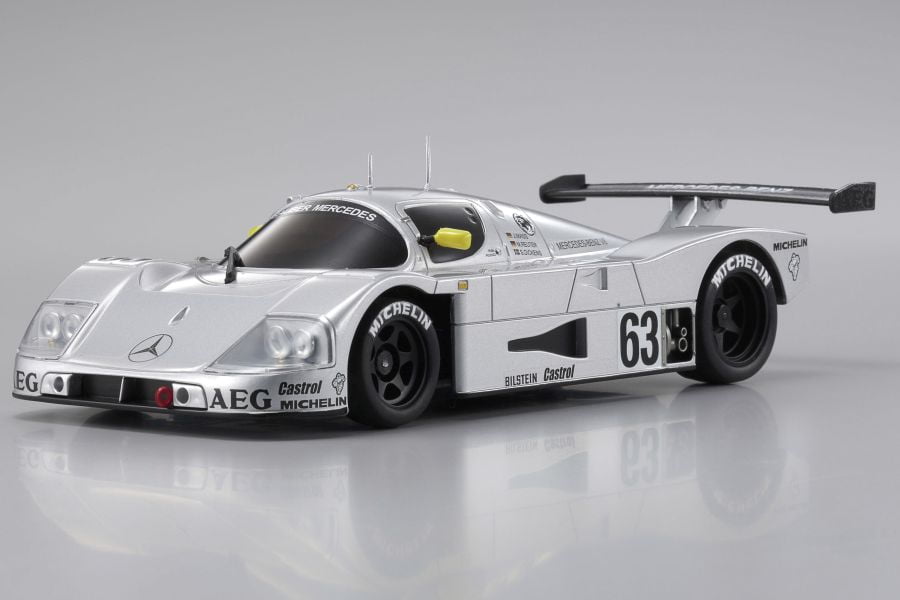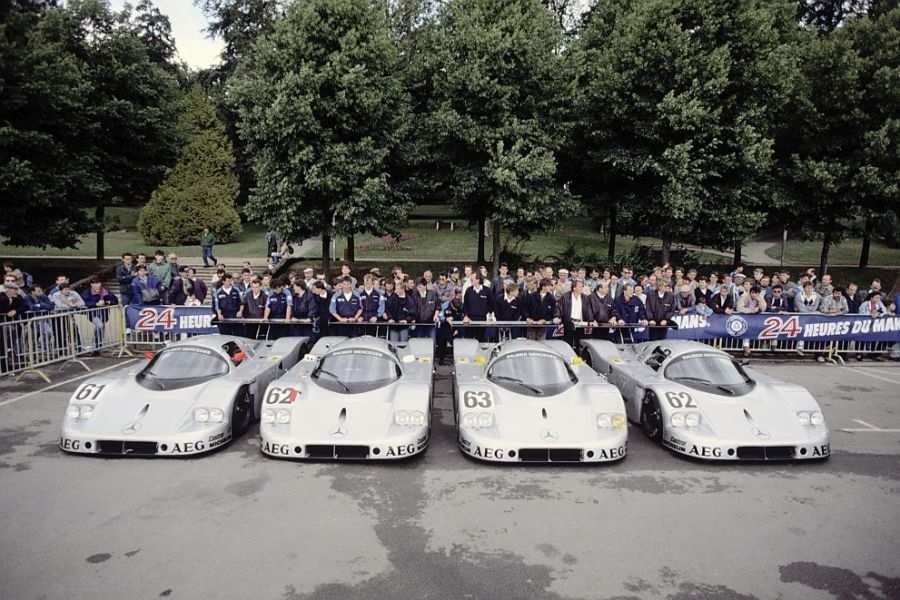Sauber C9 - One of Two Mercedes Cars to Win Le Mans
The Sauber C9 (also known as Sauber Mercedes C9, Sauber C9-Mercedes or Mercedes-Benz C9) was a Group C prototype race car which was in use for three full seasons, from 1987 to 1989, in the World Sportscar Championship and at 24 hours of Le Mans.
Sauber C9 achieved the greatest success in 1989, winning both drivers’ and teams’ WSC titles, but also winning Le Mans 24h race, being the second and last Mercedes car in a history to do that. Except for C9, only Mercedes which won at Le Mans was W194 back in 1952.
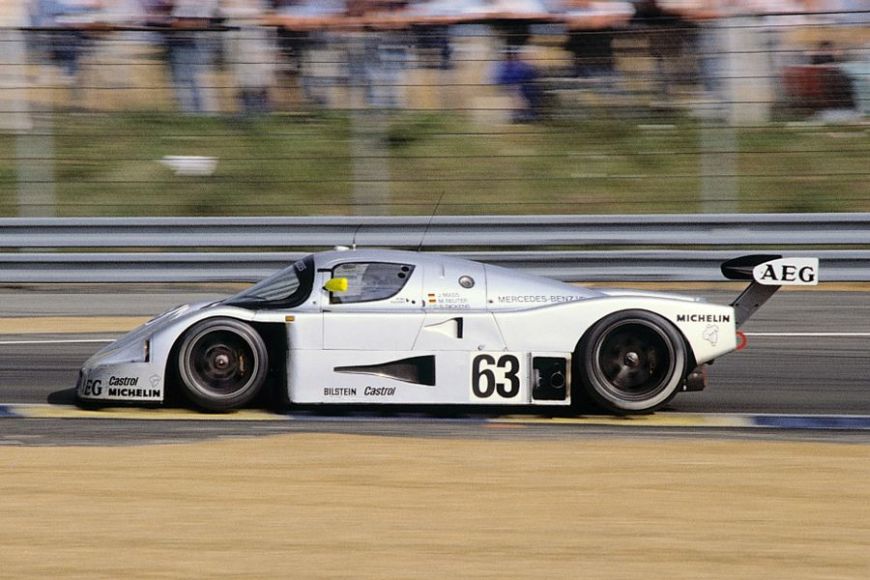
Le Mans-winning Sauber C9-Mercedes
Sauber C9 succeeded not so successful C8
A story about Sauber C9 started with its predecessor Sauber C8, introduced at 1985 Le Mans race. The C8 marked a switch for Sauber from the previous BMW and Chevrolet engines to the Mercedes M117 5.0-litre V8 engine.
The C9 was introduced two years later, a couple of months before Le Mans race, with the same Mercedes powerplant.
C9’s design was an evolution of C8
Considering design, the C9 was an evolution of C8. It retained light alloy monocoque chassis but considerably stiffer and with numerous other improvements. The rear suspension changed from vertically positioned spring/damper units to a horizontal layout. Aerodynamic changes included the repositioning of the oil/water radiator to the nose of the car. The rear deck had been redesigned and the rear wing was mounted solely on a central support.
The engine for the C9 was again prepared by Swiss engine specialist Heini Mader. The engine was lightened compared to the previous generation and KKK turbochargers became more efficient. The engine produced about 800 hp, what was outstanding number considering only 905 kilos of weight.
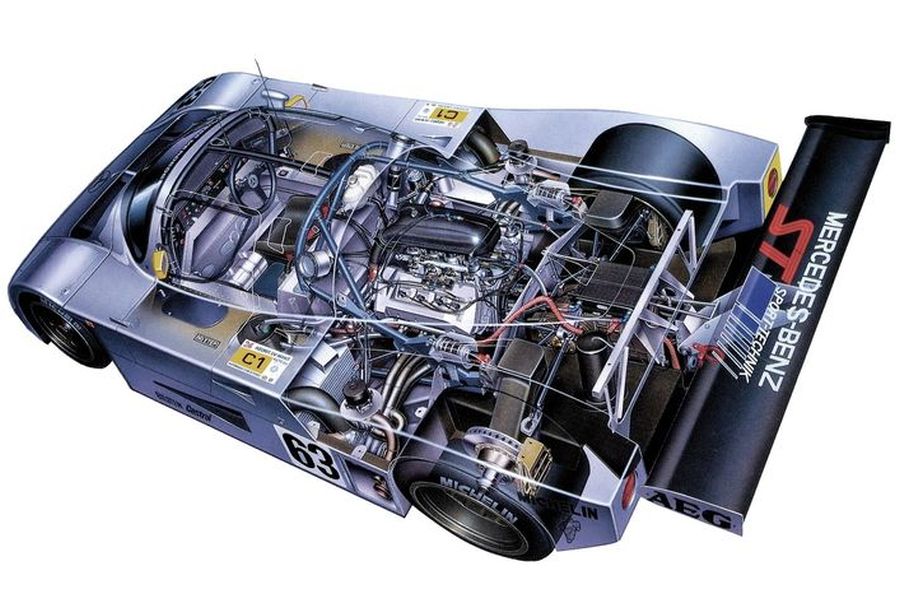
Sauber C9-Mercedes cutaway
Sauber C9 debuted at 1987 1000 km of Silverstone
In debut season, two Sauber C9 cars were run by Kouros Racing, named after the fragrance brand of its parent company (Yves Saint Laurent) and officially backed by Mercedes-Benz. The #61 car debuted in the fourth round of the 1987 World Sportscar Championship, the 1000 km of Silverstone, driven by Henri Pescarolo and Mike Thackwell. They didn’t manage to finish the race.
Double retirement at 1987 Le Mans
In the next race, the 24 hours of Le Mans, both cars were on the grid and both retired. The #61 was driven by Pescarolo, Thackwell and Hideki Okada. The #62 was driven by Thackwell, Chip Ganassi and Johnny Dumfries. The car showed its potential when Dumfries set a lap record at Le Mans before retiring with gearbox failure.
Only one non-championship win in 1987
Later in the season, Mike Thackwell took pole position at Spa and finished in the seventh place, sharing the #61 car with Jean-Louis Schlesser. The team scored their first and only points in that season, finishing 12th in the final standings. Schlesser won the final race of the year, the non-championship Nurburgring Supercup, which was the only win in a bad season for the team.

Black Sauber C9 scored five WSC wins in 1988
Five wins in the 1988 World Sportscar Championship
The completely different story followed in the 1988 World Sportscar Championship, in which team was renamed to Sauber Mercedes. Sauber C9 showed not only improved reliability but became one of only two winning cars, the other was Jaguar XJR-9.
Sauber Mercedes scored five wins, Silk Cut Jaguar took six wins and won the championship titles both in drivers’ and teams’ category. Sauber’s drivers Jean-Louis Schlesser, Mauro Baldi and Jochen Mass finished second, third and fifth respectively behind Jaguar’s champion Martin Brundle.
Sauber Mercedes withdrew from 1988 Le Mans
Sauber C9 was a victorious car at Jerez, Brno, Nurburgring, Spa-Francorchamps and Sandown Park, but not at Circuit de la Sarthe. In a fact, Sauber Mercedes didn’t participate at 1988 24 hours of Le Mans, as the team embarrassingly withdrew due to concern over their Michelin tires after Klaus Niedzwiedz suffered a blowout at high speed during a practice.
During the season, eight drivers were sharing the cockpits of two cars (#61 and #62): Jean-Louis Schlesser, Mauro Baldi, Jochen Mass, Stefan Johansson, James Weaver, Kenny Acheson, Philippe Streiff and Klaus Niedzwiedz.
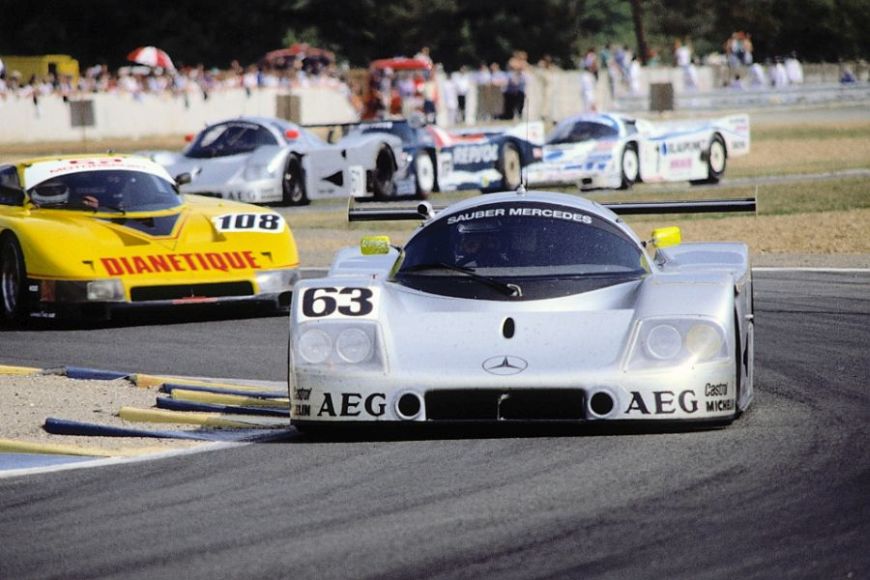
The #63 Sauber C9-Mercedes won the 1989 Le Mans 24 hours
Silver-colored C9 repeated a result of original Silver Arrow from 1952
Finally, in 1989, the Sauber C9 became the world’s most successful prototype race car. Before the season started, the older M117 5.0 V8 engine was replaced with M119 5.0 V8, which was lighter because aluminium heads were installed instead steel heads. The team also changed a colour scheme, using a traditional Mercedes ‘Silver Arrows’ paint.
The 1989 Silver Arrow repeated the result of the original Silver Arrow W194, which took only Mercedes’ victory at Le Mans in 1952. Except for victory of Jochen Mass, Manuel Reuter and Stanley Dickens in the #63 Sauber C9, the race was marked by speed record of the #61 car during qualifying.
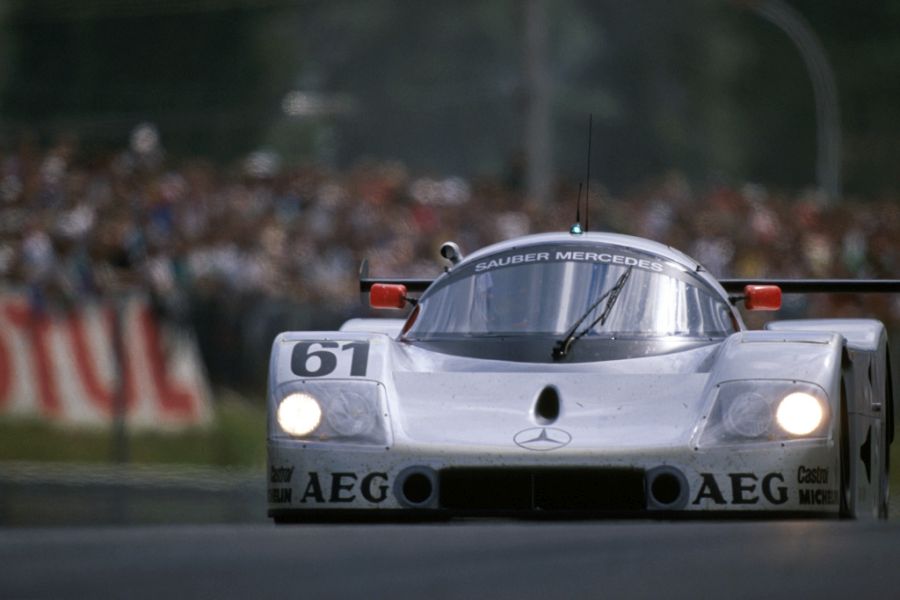
#61 Sauber C9 reached a speed of 400 km/h
Sauber C9 reached 400 km/h on the Mulsanne Straight
The car reached a speed of 400 km/h (248 mph) on the Mulsanne Straight, what was one of the highest top speeds in the history of the competition at Le Mans. That speed, together with 1988’s record of 405 km/h by the WM Peugeot, caused an introduction of two chicanes at Mulsanne Straight in 1990.
Two Sauber-Mercedes crews on the Le Mans podium
In the 1989 Le Mans race, Sauber Mercedes finished first, second and fifth. Mass/Reuter/Dickens won the race in the #63 car, with 389 laps around Circuit de la Sarthe during 24 hours of racing. Mauro Baldi, Kenny Acheson and Gianfranco Brancatelli finished second in the #61 car, five laps behind the winners. The podium was completed by Porsche’s Hans-Joachim Stuck and Bob Wollek. The third Sauber C9 (#62), driven by Jean-Louis Schlesser, Jean-Pierre Jabouille and Alain Cudini, finished in the fifth place.

1989 Le Mans podium
C9 was a dominant force in the 1989 world championship
Le Mans race was not a part of the 1989 World Sports Car Championship. In the championship, Sauber Mercedes won seven out of eight races, missing only a victory at Dijon-Prenois.
Jean-Louis Schlesser would end up taking the driver’s championship that season, with other three drivers occupying positions from P2 to P4 – Mass, Baldi, Acheson. In the teams’ standings, Sauber Mercedes dominantly took the title ahead of two Porsche teams Joest Racing and Brun Motorsport.
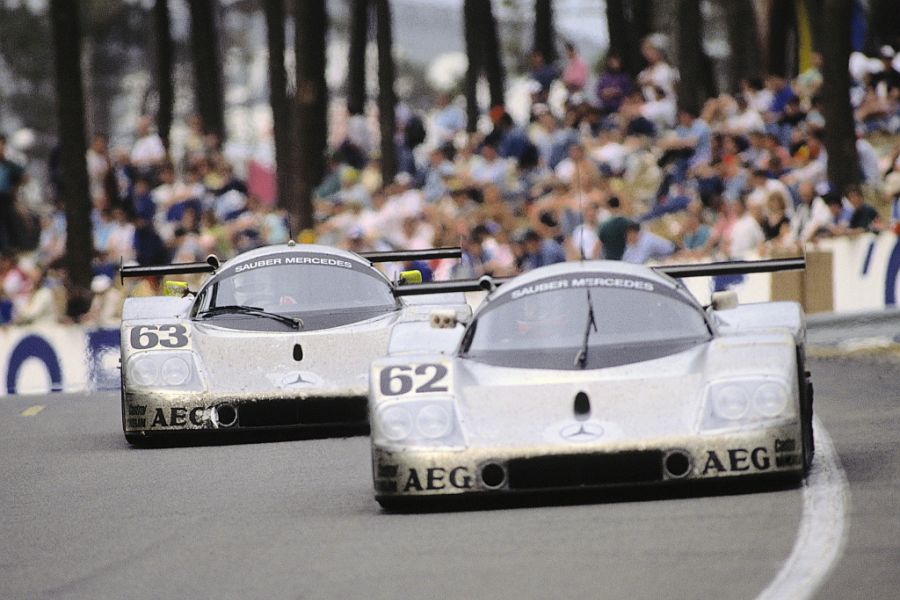
Two Sauber C9s at 1989 Le Mans
Farewell victory at Suzuka, C11 came as a replacement
For the 1990 World Sportscar Championship, the C9 was replaced by Mercedes-Benz C11. In the opening race of the season, at Suzuka Circuit in April, the team was using C9 one more time, with numbers 1 and 2 on it, taking the farewell victory. Mauro Baldi and Jean-Louis Schlesser won the race, Jochen Mass and Karl Wendlinger were second.
After three full seasons plus one race, C9 ended its competitive life with 17 wins on its account (1 Le Mans, 12 WSC, 4 Supercup), earning a special place in Mercedes’ motorsport history as one of only two cars to win Le Mans 24 hours.
| Specifications | |
| Type | Racing Car |
| Production years | 1987-1989 |
| Origin country | Switzerland |
| Cars built | 6 |
| Drivetrain | |
| Body / Frame | Aluminum Tub Monocoque w/Steel Rear Subframe |
| Transmission | 5-speed Hewland Manual |
| Engine | |
| Configuration | Mercedes-Benz M119 HL 90º V8 |
| Aspiration | Twin KKK Turbos |
| Engine weight | 191 kg / 421.1 lbs |
| Compression | 8.5:1 |
| Displacement | 4,973 cc / 303.5 cu in |
| Torque | 810 Nm / 597 ft lbs @ 3,500 rpm |
| Power | 720 bhp / 537 KW @ 7,000 rpm |
| Power / Weight | 0.8 bhp / kg |
| Dimensions | |
| Weight | 905 kg (1,995.2 lb) |
| Length | 4,800 mm (189.0 in) |
| Width | 2,000 mm (78.7 in) |
| Height | 1,070 mm (42.1 in) |
| Wheelbase | 2,770 mm (109.1 in) |
Photos: media.daimler.com


